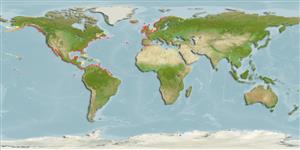Hydrozoa |
Leptothecata |
Haleciidae
Environment: milieu / climate zone / djupintervall / distribution range
Ekologi
; brackvatten; djupintervall 0 - 31 m (Ref. 87156). Polar
Mediterranean, Atlantic and Arctic Oceans: Mostly polar, but also in subtropical, tropical and boreal.
Length at first maturity / Size / Weight / Age
Könsmognad: Lm ? range ? - ? cm
Minimum depth from Ref. 116013. Known from mangroves (Ref. 86642), tidal inlets, exposed areas of bays, including any ledges at their entrance and surface or near surface water layers, including porpitids and the halopelagic Sargassum sp. fauna; limited to shallow benthic habitats (Ref. 86643). Also found in Carrie Bow Cay, Belize, in patch reefs, Thalassia sp. beds, back reef, outer ridge and fore-reef slopes on substrates composed of dead corals and gorgonians at depths of 3 to 31 m. As with other hydroids, this species exhibits a pelagic medusoid stage (Ref. 87156). Epipelagic (Ref. 116013).
Life cycle and mating behavior
Könsmognad | Reproduktion | Lek | Eggs | Fecundity | Larvae
Reproduction occurs only in hydroid stage (Ref. 1663, p. 20). Period of reproductive maturity recorded for Carrie Bow Cay, Belize is 10th to 19th May, during which the sample collected had gonophores or medusa buds (Ref. 87156).
Cairns, S.D., D.R. Calder, A. Brinckmann-Voss, C.B. Castro, D.G. Fautin, P.R. Pugh, C.E. Mills, W.C. Jaap, M.N. Arai, S.H.D. Haddock and D.M. Opresko 2003 Common and Scientific Names of Aquatic Invertebrates from the United States and Canada: Cnidaria and Ctenophore, Second Edition. American Fisheries Society Special Publication, no,28. XI+115. With CD-ROM. (Ref. 1663)
IUCN Red List Status
(Ref. 130435: Version 2025-1)
CITES status (Ref. 108899)
Not Evaluated
Not Evaluated
Threat to humans
Human uses
| FishSource |
Verktyg
Ytterligare information
Trophic EcologyFood items (preys)
Födosammansättning
Födointag
Predatorer
Population dynamicsTillväxtMax. ages / sizesLength-weight rel.Length-length rel.Length-frequenciesMass conversionAbundans PhysiologySyreförbrukning
Human RelatedStamps, coins, misc.
Internet-källor
Estimates based on models
Preferred temperature
(Ref.
115969): 7.1 - 26.1, mean 11.6 (based on 1237 cells).
Price category
Unknown.
